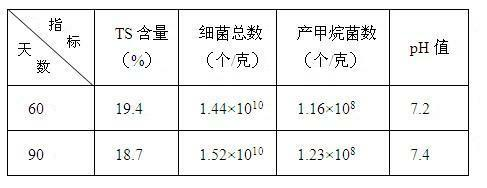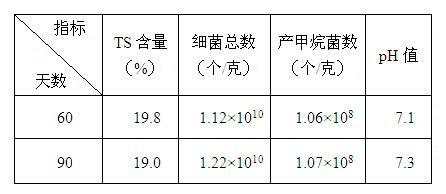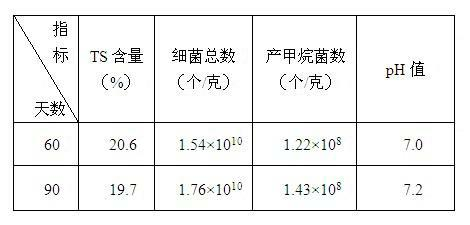Preparation method of methane dry fermentation compound bacterial preparation
A compound bacterial agent, dry fermentation technology, applied in microorganism-based methods, biochemical equipment and methods, bacteria and other directions, can solve the problems of narrow use range, no mention of dry fermentation, etc., and achieve low cost, rich enzyme production, Removing the effects of feedback inhibition
- Summary
- Abstract
- Description
- Claims
- Application Information
AI Technical Summary
Problems solved by technology
Method used
Image
Examples
Embodiment 1
[0043] The composite strain of the present invention is composed of 11 strains of bacteria, and according to the different functions in the fermentation process, these 11 strains of bacteria can be divided into the following 6 categories:
[0044] Cellulolytic bacteria: Bacteroides cellulosilyticus , Clostridium sufflavum ;
[0045] Proteolytic bacteria: Clostridium pasteurianum ;
[0046] Lipolytic bacteria: Syntrophomonas sapovoran s;
[0047] Sulfate reducing bacteria: Desulfovibrio desulfuricans , Desulfobulbus rhabdoformis ;
[0048] Hydrogen-producing acetogenic bacteria: Syntrophomonas Wolfei ;
[0049] Methanogenic archaea: Methanospirillum hungatei , Methanocorpusculum parvum , Methanosarcina barkeri , Methanosaeta concilii .
[0050] The above-mentioned 11 strains of cellulolytic bacteria, proteolytic bacteria, lipolytic bacteria, hydrogen-producing acetogenic bacteria, sulfate-reducing bacteria and methanogenic archaea were directly mixed ...
Embodiment 2
[0054] The composition ratio of the 11 strains in the inoculum is as follows: Bacteroides cellulosilyticus 22%, Clostridium sufflavum 17%, Clostridium pasteurianum 10%, Desulfobulbus rhabdoformis 11%, Syntrophomonas sapovorans 11%, Syntrophomonas Wolfei 10%, Desulfovibrio desulfuricans 13%, Methanospirillum hungatei accounting for 0.5%, Methanocorpusculum parvum 1.0%, Methanosarcina barkeri 1.5%, Methanosaeta concilii 3%.
[0055] A mixture of pig manure and corn stover was used as fermentation substrate. The corn stalks were pulverized into powder, mixed with pig manure in a ratio of 1:1 by mass, and water was added to adjust the TS content to 30%, and composted at natural temperature for 7 days. After composting, adjust the pH value to 7.0 with lime powder, and then add the above inoculum according to raw material: inoculum = 10:3 (mass ratio), after mixing evenly, the moisture content of the mixture can be adjusted to 80%, and at 35 Anaerobic culture ...
Embodiment 3
[0058] The inoculum consisted of the following 11 strains, Bacteroides cellulosilyticus 20%, Clostridium sufflavum 15%, Clostridium pasteurianum 12%, Desulfobulbus rhabdoformis 11%, Syntrophomonas sapovorans 13%, Syntrophomonas Wolfei 10%, Desulfovibrio desulfuricans 13%, Methanospirillum hungatei 1.0%, Methanocorpusculum parvum 1.5%, Methanosarcina barkeri 2%, Methanosaeta concilii 1.5%.
[0059] A mixture of pig manure and rice straw was used as fermentation substrate. The straw stalks were pulverized into powder, mixed with pig manure in a ratio of 1:1 by mass, added water to adjust the TS content to 25%, and composted for 7 days at natural temperature. After the composting, the pH value was adjusted to 6.5 with lime powder, and the above-mentioned inoculum was added according to the fermentation substrate: inoculum=10:3 (mass ratio). After mixing evenly, anaerobic culture was carried out at 35±2°C. After 60 to 90 days, the compound bacterial agent i...
PUM
 Login to View More
Login to View More Abstract
Description
Claims
Application Information
 Login to View More
Login to View More - R&D
- Intellectual Property
- Life Sciences
- Materials
- Tech Scout
- Unparalleled Data Quality
- Higher Quality Content
- 60% Fewer Hallucinations
Browse by: Latest US Patents, China's latest patents, Technical Efficacy Thesaurus, Application Domain, Technology Topic, Popular Technical Reports.
© 2025 PatSnap. All rights reserved.Legal|Privacy policy|Modern Slavery Act Transparency Statement|Sitemap|About US| Contact US: help@patsnap.com



